By Lauren Soos and Kenneth Cottrell
The Brandywine Superfund Site, located on offsite property of Joint Base Andrews, Md., was initially used by the U.S. Navy as a storage area from 1943 through 1961. From 1961 to 1987, the site was operated by the U.S. Air Force as a storage area for waste and excess government material generated by operations at a number of defense installations, including Andrews AFB, Bolling AFB, Washington Navy Yard, Naval Ordnance Station-Indian Head, and White Oak Laboratory.
According to Air Force records, hazardous materials and wastes, including spent solvents, were stored at the site within drums and several concrete bins. However, detailed information on where solvent drums were stored and how the wastes were handled at the site was not available.
As part of the site cleanup, the Omaha District of the U.S. Army Corps of Engineers (USACE), on behalf of the Air Force, selected HydroGeoLogic and TRS Group to perform the final groundwater remedy. Conducting this remediation project required careful navigation and planning, as the 49,000-yd³ treatment volume was located beneath and divided by a public roadway, a water and sewer main, private and government land, and two active CSX Transportation railroad tracks.
CONTAMINANTS OF CONCERN
The contaminants of concern at the Brandywine site were chlorinated volatile organic compounds (CVOCs)—primarily trichloroethylene (TCE) and 1,4 dichlorobenzene (DCB). Following the interim remedy, which consisted of 4.5 years of groundwater pump and treat and three injection rounds of substrates for enhanced reductive dechlorination, the groundwater plume was reduced from 20-acres to 1.5-acres, representing more than a 90 percent area reduction. High resolution site characterization techniques with membrane interface probes and passive flux meters identified a low permeability clay unit approximately 30-ft below ground surface as the continuing source of CVOC contamination and rebound. The results indicated a residual source mass of about 300-lb.
Overall, the remedial objective was to reduce TCE and DCB groundwater concentrations to a maximum level of 5-μg/l and 75-μg/l, respectively.
Innovative Treatment Approach. To complete the remediation of the groundwater plume source, the project team utilized OptiFlux electrical resistance heating (ERH). This approach passes an electrical current through the soil and groundwater to remove both TCE and DCB. As electrical power is applied to the treatment volume, the soil’s natural resistance to the flow of electrical current creates heat, which converts the liquid and sorbed phase CVOCs to vapor. Eventually, the temperature reaches the boiling point of water, converting the groundwater and soil moisture to steam and acting as a carrier gas for the volatilized contaminants. The vapor recovery system collects the steam and target contaminants in the vadose zone for subsequent treatment by the above-grade vapor treatment equipment.
Implementing this final remedy required coordination with many local and federal stakeholders in addition to the Air Force and USACE Omaha District. Partners included CSX, Environmental Protection Agency Region 3, Maryland Department of the Environment, Prince George’s County Department of Health, Prince George’s County Department of Permitting, Inspections & Enforcement, the Washington Sanitary Sewer Commission, and several private landowners.
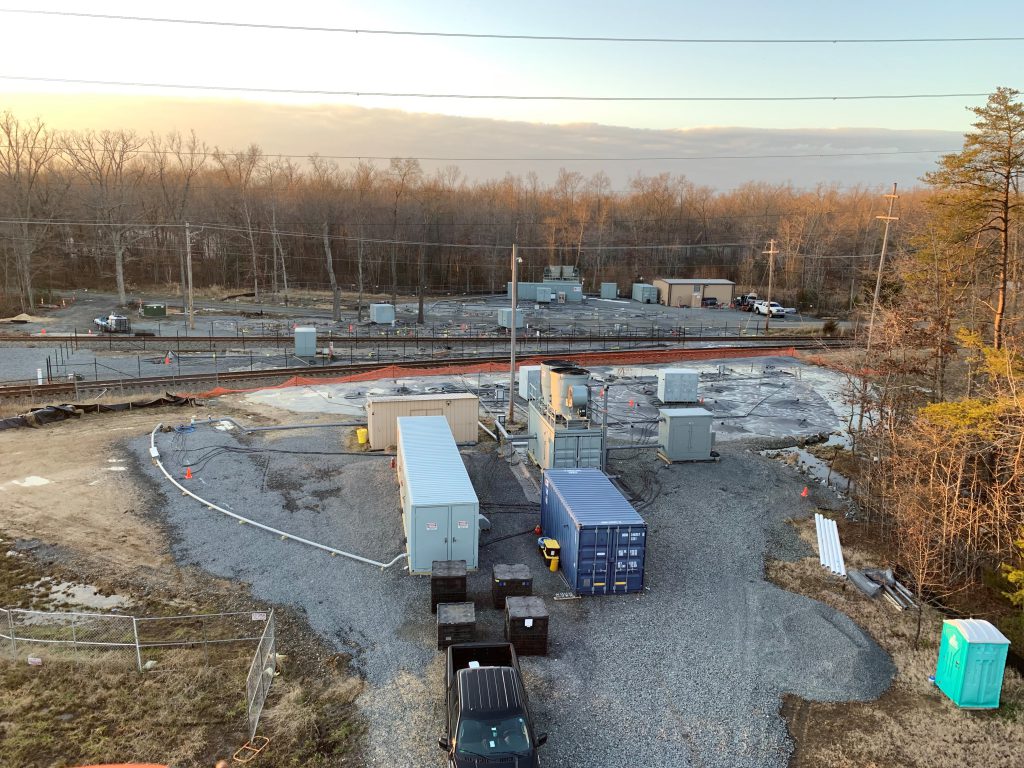
CAREFUL DESIGN
To apply ERH to the full treatment volume, installation of electrodes between two active railroad tracks and within the CSX right-of-way was essential. During system installation, on-site CSX oversight and rail watch was required to avoid disrupting rail service and maintain site worker safety.
Since the railroad tracks were active, placing the electrode power cables and vapor recovery conveyance piping on or near the tracks was not an option. Consequently, cable and conveyance piping was placed under the railroad tracks using jack-and-bore conduits (so not to disrupt rail service or the integrity of the tracks). A series of four 6-in steel pipes were installed under the tracks and used as conduits, making necessary connections between the primary utility power service and the ERH equipment compounds and portions of the treatment area between the tracks.
Due to the location of the tracks, two ERH equipment compounds were designed, one for each of the two distinct treatment areas east and west of the tracks. Additionally, during system construction and operations, real-time elevation monitoring of the tracks was incorporated. By employing an Automated Motorized Total Station monitoring system, a laser was used to measure the movement of more than 100 mirror survey prisms mounted to the steel rail of the tracks.
Prior to operations, numerous track deformation response levels were identified, along with subsequent actions to ensure health and safety. If a change in track elevation of 0.75-in was detected, notification and inspection was required. If a change of 1.5-in was detected, the ERH system was required to be shut down. This response level contained a safety factor of 0.5-in to the Federal Track Safety Standards, 49 CFR Part 213.
Construction Work Begins. Subsurface construction of the ERH began in July 2018. The system incorporated 43 vertically bored electrode pairs and 58 sheet pile electrodes across the treatment area. Vertically bored electrodes were used where stakeholder or utility clearance did not allow for the installation of sheet piles. In these areas, a sheet pile electrode was substituted in. A vapor recovery plenum also was installed over the treatment area. In total, 17 temperature monitoring points and eight compliance groundwater monitoring wells were installed.
System operations began in April 2019 and ran for 214 days. It applied 7.4-milion-kWh of energy into the treatment volume, removing approximately 1,716-lb of volatile organic compounds. On average, subsurface temperatures within the treatment volume increased at a rate of approximately 1.4°-C/day as the temperature increased from ambient to boiling temperatures.
Weekly track monitoring updates were provided during operations. Track elevation changes (continuously recorded by the Automated Motorized Total Station) were below the lowest response limits approved by CSX.
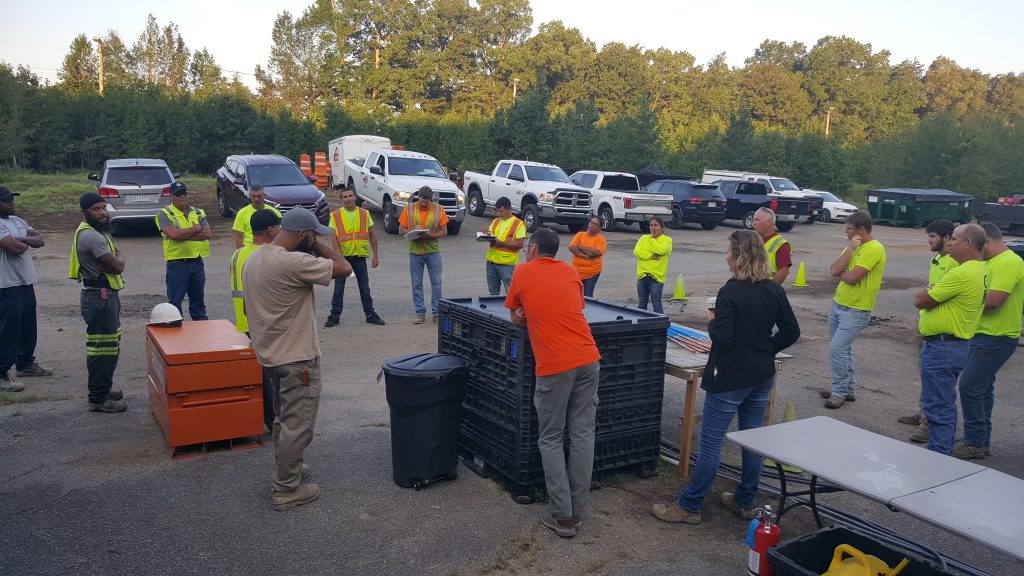
MEETING OBJECTIVES
During system operation, groundwater samples were collected from nine monitoring wells within the treatment area. The first round of confirmation groundwater samples was collected in June 2019. The last round was collected in November 2019. Due to the existing tight clay formations, the recharge of groundwater to several of the wells was slow to virtually non-existent during electrical energy application. During system operation, power application was interrupted for a total of 31 days to allow for groundwater recharge into the treatment volume.
To accommodate groundwater recharge, power application to the treatment volume ceased in October 2019. The results of the November 2019 confirmation groundwater sampling indicated all samples met the treatment goals of 5-μg/l TCE and 75-μg/l DCB—with the exception of the sample from monitoring well DP61, which had a concentration of 5.68-μg/l TCE.
Stakeholder concurrence was received that remedial action objectives were met. Demobilization activities began shortly after and concluded in December 2019, after which the Air Force, CSX, and private property owners agreed that restoration activities had been satisfactorily completed.
More News from TME
-
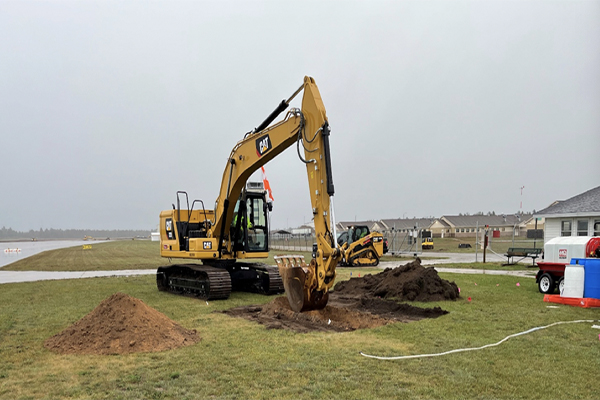
Eliminating PFAS Leaching at Camp Grayling
At Camp Grayling, a novel colloidal-activated carbon material was used as a horizontal barrier on a site where aqueous film-forming foam had previously been discharged to prevent PFAS from leaching into groundwater. -
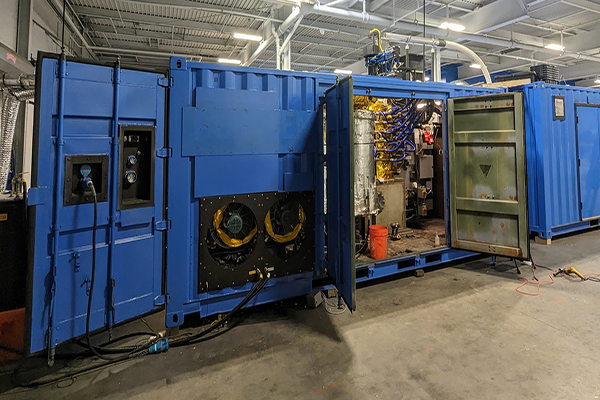
Reaching Sustainability Goals with Waste-to-Energy
The U.S. Army Engineer Research & Development Center’s Construction Engineering Research Laboratory is working to develop small-scale waste-to-energy systems that will advance installation sustainability and waste management. -
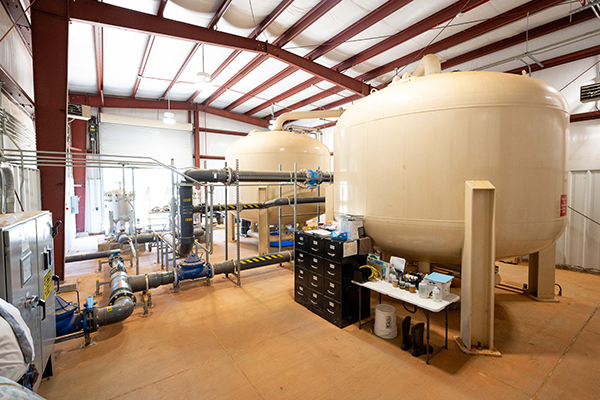
Investigating Emerging PFAS Destruction Technologies
Following recent interim guidance from the Department of Defense on how military organizations are to handle the destruction and disposal of PFAS, developing technologies that target the destruction of these forever chemicals hold possibilities for effective and efficient removal.